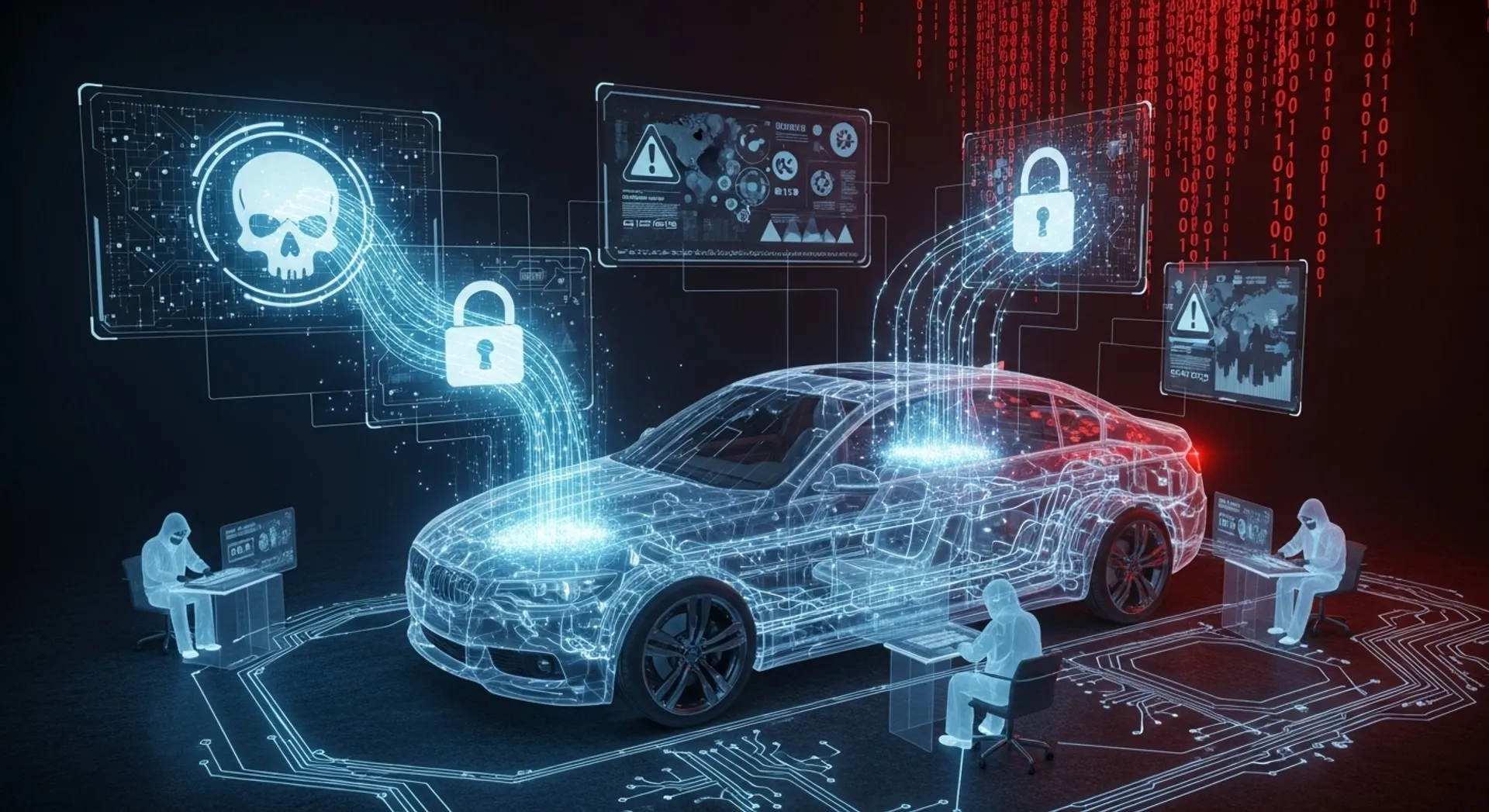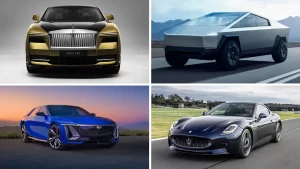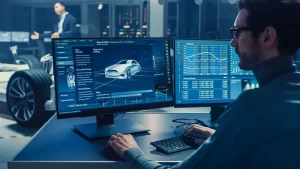Your car is watching, listening, and talking to the world around it. Modern vehicles generate up to 25 gigabytes of data per hour, connecting to satellites, cellular networks, and other vehicles constantly. While this connectivity enables incredible features like real-time navigation, over-the-air updates, and autonomous driving, it also creates a troubling reality — your car has become a prime target for hackers.
The automotive cybersecurity landscape in 2025 has evolved from a theoretical concern to a pressing crisis that affects millions of drivers worldwide. As vehicles transform into sophisticated computers on wheels, the question is no longer if cars can be hacked, but when and how severe the consequences will be.
The Growing Threat Landscape
Connected vehicles represent a convergence of multiple technologies — GPS, Bluetooth, Wi-Fi, cellular networks, and vehicle-to-everything communication systems. Each connection point serves as a potential entry for malicious actors. Unlike your laptop or smartphone, a compromised vehicle poses not just privacy concerns but immediate physical safety risks.
According to the Cybersecurity and Infrastructure Security Agency, the automotive industry has witnessed a dramatic increase in cyber incidents over the past three years. The complexity of modern vehicles, which can contain over 100 million lines of code — more than a Boeing 787 Dreamliner — creates an expansive attack surface that cybercriminals are actively exploiting.
Real-World Hacking Incidents
The threat is not hypothetical. In recent years, security researchers have demonstrated the ability to remotely control vehicle functions including steering, braking, and acceleration. In one notable incident, researchers compromised a popular vehicle model’s infotainment system and gained access to critical driving functions while the car was traveling at highway speeds.
Even more concerning, cybercriminals have targeted keyless entry systems, allowing them to steal vehicles in minutes without traditional break-in methods. Insurance companies report that keyless car theft has surged, with certain luxury brands experiencing theft rates five times higher than vehicles with traditional keys.
How Hackers Target Your Vehicle
Understanding the methods hackers use helps drivers recognize vulnerabilities and take protective action. The attack vectors continue to evolve as vehicles become more sophisticated.
Over-the-Air Update Vulnerabilities
While over-the-air updates represent a convenient way for manufacturers to fix bugs and add features, they also create opportunities for interception. If not properly secured with encryption and authentication, hackers can potentially inject malicious code during the update process. A compromised update could theoretically affect thousands of vehicles simultaneously, creating a fleet-wide security incident.
Infotainment System Exploitation
The infotainment system serves as the primary interface between drivers and their vehicles, but it also represents one of the most accessible entry points for hackers. Many infotainment systems connect to smartphones via Bluetooth or USB, and a malicious app or infected device could serve as a gateway to deeper vehicle systems.
Once inside the infotainment system, sophisticated attackers can potentially pivot to more critical vehicle networks. Despite architectural efforts to isolate entertainment systems from safety-critical functions, researchers have repeatedly demonstrated methods to breach these barriers.
Keyless Entry System Attacks
Keyless entry and push-button start systems use radio frequency signals that hackers can intercept and amplify. Using relatively inexpensive equipment purchased online, thieves can capture the signal from your key fob inside your home and relay it to your vehicle parked outside, tricking the car into thinking the key is present.
This relay attack requires no technical breaking and entering, no forced ignition, and leaves no traditional signs of theft. The vehicle simply unlocks and starts as if the owner was present with the legitimate key.
Connected Services and Third-Party Apps
Many vehicles now offer smartphone apps that allow owners to remotely start, lock, unlock, or track their vehicles. While convenient, these apps create additional attack surfaces. A vulnerability in the app or its backend server could potentially give hackers access to multiple vehicles.
Third-party connected devices like insurance dongles, GPS trackers, or aftermarket telematics also introduce risks, especially if they connect to the vehicle’s internal communication networks without proper security protocols.
The Impact Beyond Vehicle Theft
While car theft represents the most obvious concern, the implications of automotive cybersecurity breaches extend far beyond property loss.
Personal Data Privacy
Your vehicle knows where you go, when you go there, and how fast you drive. It knows your home address, your workplace, your favorite restaurants, and perhaps your extramarital meeting spots. This treasure trove of personal data becomes vulnerable when vehicle systems are compromised.
Researchers from Mozilla Foundation found that modern cars collect extensive personal information, often sharing or selling this data to third parties. A cybersecurity breach could expose years of location history, personal contacts, calendar appointments, and even recorded in-cabin conversations.
Safety and Physical Harm
The most alarming scenario involves hackers gaining control of safety-critical systems. While manufacturers implement multiple layers of protection, the increasing integration of drive-by-wire systems — where electronic signals rather than mechanical linkages control steering, braking, and acceleration — means that a successful attack could theoretically influence vehicle behavior.
Even less dramatic interference could prove dangerous. Imagine your vehicle’s dashboard suddenly going dark while driving at night, or your brakes unexpectedly engaging on a highway. These scenarios move beyond inconvenience into genuine safety threats.
Ransomware and Extortion
As vehicles become more dependent on software, they become vulnerable to ransomware attacks. Hackers could theoretically lock owners out of their vehicles or disable critical functions, demanding payment for restoration. Fleet operators — delivery services, ride-sharing companies, or car rental agencies — represent particularly lucrative targets where disabling multiple vehicles simultaneously could cause significant business disruption.
Industry Response and Regulations
The automotive industry has begun taking cybersecurity seriously, though critics argue the response has been reactive rather than proactive. Major manufacturers now employ dedicated cybersecurity teams and conduct penetration testing during vehicle development.
Regulatory Framework Development
Governments worldwide are implementing regulations to mandate minimum cybersecurity standards. The United Nations regulation UN R155 requires manufacturers to demonstrate cybersecurity management systems and regularly update vehicle security. The European Union has made compliance mandatory for new vehicle types, and other regions are following suit.
These regulations represent important progress, but the rapidly evolving threat landscape means that standards must continuously adapt. What constitutes adequate security today may prove insufficient tomorrow as hackers develop new techniques.
Manufacturer Security Measures
Leading automakers have established bug bounty programs, inviting security researchers to identify vulnerabilities in exchange for financial rewards. This approach harnesses the cybersecurity community’s expertise while encouraging responsible disclosure rather than black-market exploit sales.
Manufacturers are also implementing security-by-design principles, building protection into vehicles from the ground up rather than adding it as an afterthought. This includes encrypted communication channels, multi-factor authentication for sensitive functions, and intrusion detection systems that monitor for suspicious activity.
Protecting Your Connected Vehicle
While manufacturers bear primary responsibility for vehicle security, drivers can take practical steps to reduce their risk exposure. At C-A-R, we believe informed drivers make safer decisions.
Update Your Vehicle Software Regularly
Just like your smartphone or computer, your vehicle’s software requires regular updates to patch security vulnerabilities. Enable automatic updates if your vehicle supports them, or check manually at least monthly. Delaying updates leaves known vulnerabilities unpatched and your vehicle exposed.
Secure Your Key Fob
Store your key fob in a signal-blocking pouch or metal container when at home, preventing relay attacks. These Faraday pouches are inexpensive and effectively block the radio signals that relay attack devices depend on. Additionally, some vehicles allow you to disable keyless entry features when not needed, providing an extra layer of security.
Be Cautious With Connected Apps and Devices
Only download official apps from your vehicle manufacturer through legitimate app stores. Be wary of third-party apps claiming to offer additional vehicle connectivity features. Review and limit the permissions you grant to automotive apps, especially location access when not actively using navigation features.
Before installing aftermarket connected devices like dash cams or GPS trackers, research their security practices and reviews. Cheap, no-name devices may lack basic security measures and create vulnerabilities.
Monitor Your Vehicle for Unusual Behavior
Pay attention to unexpected behaviors like systems activating without input, unusual error messages, or unexplained battery drain. While these often have innocent explanations, they could indicate tampering or compromise. If you notice persistent anomalies, have your vehicle inspected by an authorized dealer.
Protect Your Personal Data
Before selling or returning a leased vehicle, ensure you completely delete all personal data. Most modern vehicles have a factory reset option that clears saved destinations, phone contacts, and paired devices. Review your vehicle’s privacy settings periodically and adjust what data you allow it to collect and share.
The Road Ahead
The automotive cybersecurity challenge will intensify as vehicles become more connected and autonomous. The transition to software-defined vehicles and advanced driver assistance systems increases both capability and vulnerability.
However, the situation is not hopeless. The industry is learning from other sectors that faced similar challenges, such as aviation and healthcare, which have developed robust security frameworks over time. Collaboration between manufacturers, cybersecurity experts, regulators, and law enforcement continues to improve.
As consumers, we must balance enthusiasm for connected vehicle features with realistic awareness of the risks. The convenience of remote start or over-the-air updates should not blind us to the security implications. By understanding the threats and taking reasonable precautions, we can enjoy the benefits of automotive connectivity while minimizing our exposure to cybersecurity risks.
The connected car revolution is here to stay, and with it comes the responsibility to protect not just our vehicles, but our safety, privacy, and digital lives. Stay informed, stay updated, and stay secure on the road ahead.





